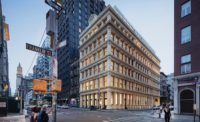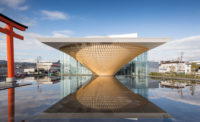The Pritzker laureate Shigeru Ban may have designed major museums and monumental concert halls, but, when it comes to testing out new ideas, nothing beats a private house. Triangle House, the architect’s latest residence, is his first realized work defined throughout by a triangular geometry. Situated on a sloping site in central Tokyo, this hybrid building combines the client’s home and office under one three-pointed roof. While the concrete-encased work space is partially embedded in the earth, the timber-capped living space, which overlooks a public park next door, is as light and airy as a treehouse. Both parts showcase the project’s expressive structural design, a signature of Ban’s architecture.
The project began with a cold call from the client, who had an irregularly shaped 5,700-square-foot parcel and a wish for a custom-designed house. As putting a business and residence in one building is common in Japan, the program was straightforward. The challenge came from the land itself. To preserve the client’s option of selling part of his property in the future, Ban configured the salable parcel first. While there is no minimum buildable lot size in Tokyo, the plot’s shape and southern exposure would have positive effects on its marketability. The architect’s calculations left a 2,100-square-foot triangular lot for the client’s building— a result that informed the geometry of everything from the overall massing of the building to an outdoor barbeque.
Integrated like pieces of a 3-D puzzle, both the home and office occupy sections of the building’s first two levels. The uppermost level is entirely dedicated to residential space. Though connected internally, the two programs are divided and have separate street-level entrances. Taking advantage of the slope, Ban situated the door to the house near the site’s high point on the east side, and the door to the office farther down the hill to the west. He created an area for off-street parking and a garage between these two entrances. The door to the house is buffered by a walled garden created by the landscape designer Seijun Nishihata, and opens into a foyer that leads to a triangular stair core. Beyond that, on the same level, is the residence, which includes a prayer room. The stairs ascend to a combined kitchen, dining, and living area, which opens onto a small terrace. On the office side, a stairway inside the entrance brings visitors and staff up to a hexagonally shaped work space, which comprises two desk-lined mezzanine levels that hug the slope and allow for an office kitchen and meeting rooms underneath.
Corresponding to the building’s functional split are two different triangulated structural systems: a 3-D wooden space frame covering the living area and a reinforced concrete waffle slab crowning the workspace. Left exposed, these elements impart a distinct atmosphere to both home and office. While the residential space feels open and expansive, the office feels protected, as if carved out of the earth. Meticulously crafted down to the smallest details, both space frame and slab constructions were designed to facilitate building on the narrow street in front of the site.
This meant using small wood members and multiple concrete pours. Measuring 3 feet deep, the space frame is constructed of untreated 6-foot-long European pine beams. They come together neatly in star-shaped joints conceived by Ban for this project in collaboration with the Swiss structural timber specialist Hermann Blumer, the architect’s regular consultant for wood joinery. Linking as many as nine elements without a glitch, the joints are secured invisibly by concealed metal plates. “Japan is heaven for construction,” says Ban, grinning. At the room perimeter, the frame edges are reinforced with C-shaped steel channels that conceal window shades and connect with slender, structural steel columns that double as mullions. A single 3-inch-diameter steel column, which offsets roof deflection and visually pins the triangular kitchen island in place, is the only vertical component in the middle of the room. The frame also transfers its load to the concrete elements that mark the corners of the triangular footprint: the stair core, the built-in barbeque, and a beefy, 3-foot-diameter column extending the height of the building.
Providing a column-free interior, the reinforced concrete waffle slab caps the main office space. Composed of three-dimensional triangular solids and voids measuring 2 feet at their apexes and 6 feet along each side, the dramatic ceiling has the crisp edges of folded origami paper. “The amount of concrete was more than the standard square waffle slab, but the formwork was much cheaper,” comments Ban. Composed of just three triangular planes, each of the formwork’s repeating units was easier to construct due partly to the shape’s inherent stability.
Preserving the integrity of the concrete surface, Ban incorporated LED uplights into built-in storage lining the room and put task lamps on the desks. Upstairs, he mounted LED fixtures into the wood ceiling at the center point of each triangular frame. Building-wide, the architect limited himself to three main finish materials: oak for the floors and millwork, white-painted steel for sashes, and, of course, concrete. In the kitchen, marbleized acrylic resin counters top the triangular island and cabinetry.
In Tokyo, where streets are widened by the city, and property is subdivided by private landowners, triangular buildings are not unusual. But this was Ban’s first structure with this strong scheme. Though born out of trouble-shooting for the future, Triangle House exemplifies the distinctive character and exquisite construction of Ban’s architecture in the here and now.
CreditsArchitect: Shigeru Ban Architects
Personnel in architect's firm who should receive special credit: Shigeru Ban Engineers Structure engineer: Hoshino Architects & Engineers, inc MEP engineer: Chiku Engineering Consalutants Landscape Consultant: Sora Botanical Garden
General contractor: Shin
Photographer: Hiroyuki Hirai, +81-90-1559-9897
|
SpecificationsStructural System Concrete, Steel and Timber Manufacturer of any structural components unique to this project: Timber Roof, triangular pyramid concrete waffle slab for 1F ceiling Exterior Cladding Masonry: Turkey travertine stone for road side wall, Sanseki Wood: Spruce timber wall, Uenojyuken Roofing Built-up roofing: Europian red pine Timber Roof Structure, Japan Kenzai Windows Metal frame: Aluminum sash, Sankyo Tateyama Interior Finishes Concrete formwork for triangular pyramid waffle slab: TOHO STAGE CRAFT |














.jpg?height=200&t=1692184429&width=200)



